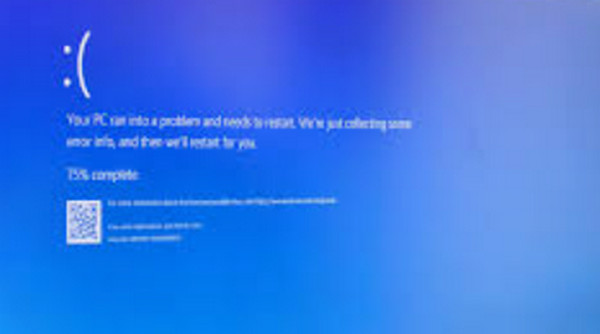
Many Windows users have reported seeing the dreaded Blue Screen of Death (BSOD) in recent weeks after applying the most current update from top cybersecurity firm CrowdStrike. Both users and IT experts are concerned about this problem, which has prompted an enquiry into the underlying reason and various remedies to lessen the impact. This article explores the intricacies of the issue, its ramifications, and the solutions being considered.
The Blue Screen of Death: What Is It?
When a system error occurs that cannot be fixed without restarting the computer, Microsoft Windows operating systems display the Blue Screen of Death (BSOD), a critical error screen. This error message is characterised by a blue background with white text that details the error code and possible reasons. It frequently indicates major problems with hardware, drivers, or important software components.
What Part CrowdStrike Plays
Well-known cybersecurity company CrowdStrike specialises in threat intelligence, endpoint security, and cyberattack response services. Businesses utilise their Falcon platform extensively to protect their digital assets from advanced cyberattacks. The platform enables real-time monitoring and remediation of possible security breaches by integrating with multiple operating system components.
The Problem with the Update
Instead of improving security features and performance overall, CrowdStrike’s Falcon platform recently received an update that many Windows users didn’t anticipate. Users started getting frequent BSODs after the update, which made their systems unstable and interfered with business activities.
User Reports and Impact: Online forums, social media sites, and technical help channels have been inundated with reports of BSOD instances. Affected customers have reported suffering problems during regular operations or shortly after their computers have booted up, which has caused annoyance and inconvenience. Companies who depend on CrowdStrike for endpoint security are in a difficult situation as they try to reconcile the update’s abrupt instability with the requirement for strong security.
Methodological Evaluation
Based on initial enquiries, it appears that there is a conflict between the most recent version of CrowdStrike and certain Windows components. The BSOD appears to be caused by a conflict between the update and some drivers or kernel-level programmes. Potential causes have been identified by technical specialists and include:
Driver Conflicts: The update can include modifications that clash with already-installed drivers, leading to unstable systems.
Kernel-Level Interference: There’s a chance that adjustments to the Falcon platform’s interface with the Windows kernel are bringing on serious problems.
Resource Containment: The update may be causing situations in which several programmes compete with one another for the same system resources, which could result in crashes.
How CrowdStrike Reacted
Following the extensive reports, CrowdStrike acknowledged the problem and initiated an internal enquiry. The business has issued statements assuring people that they are making every effort to find the source of the issue and create a solution to fix it. The impacted users are receiving active assistance from CrowdStrike’s support teams, who are also offering advice on interim fixes.
Temporary Solutions
Until CrowdStrike releases an official patch, users can take the following interim steps to lessen the severity of BSOD incidents:
Rollback the Update: System stability might be restored by going back to the CrowdStrike Falcon platform’s earlier version. Users can contact CrowdStrike support or use the platform’s administration dashboard to accomplish this.
Entering Windows Safe Mode during bootup can assist in identifying and resolving the problem. Only necessary drivers and services are loaded in safe mode, which may stop the BSOD from happening.
Turn off CrowdStrike In the short term: As a last resort, system functionality can be restored by momentarily turning off the CrowdStrike Falcon platform until a long-term solution is available. Users ought to be cautious and make sure they have other security safeguards in place.
Greater Consequences
The CrowdStrike update-related BSOD events bring to light the difficulties in preserving strong cybersecurity while guaranteeing system reliability. Companies greatly depend on endpoint protection solutions to protect their operations, but there can be dire repercussions if these solutions cause instability.
The Best Methods for Securing Endpoints
Organisations should think about implementing the following recommended practices for managing endpoint security to avoid similar problems in the future:
Staggered upgrades: Potential problems can be found before they have an impact on the overall system by implementing upgrades gradually across several organisational divisions.
Backup and Recovery: You can lessen the effects of system failures by periodically backing up important data and having a thorough disaster recovery strategy.
Monitoring and alarms: Early warnings of possible issues can be obtained by continuously monitoring system performance and configuring alarms for anomalous behaviour.
Vendor Communication: Keeping the lines of communication open with security providers guarantees prompt updates and assistance in the event of problems.
Next Actions
CrowdStrike has promised to swiftly and openly resolve the BSOD problem. It is anticipated that the business will make available a patch or upgraded Falcon platform version that fixes the compatibility issues that are causing the crashes. To reduce inconvenience and regain trust in their solution, CrowdStrike is still offering updates and help to impacted users in the interim.
In summary
The most recent CrowdStrike update-related BSOD events have brought attention to the fine line that must be drawn between upholding robust cybersecurity defences and guaranteeing system stability. Even if a lot of people have definitely experienced significant discomfort as a result of the problem, CrowdStrike’s quick response and the community’s combined efforts are encouraging first steps towards a solution. Businesses need to use best practices for managing endpoint security, be alert, and keep up with the most recent updates from their security suppliers as they navigate this difficulty.
These kinds of occurrences are crucial reminders of the difficulties in safeguarding digital assets in the constantly changing field of cybersecurity. Organisations may maintain system security while lowering the chance of unforeseen disruptions by taking preventative actions and receiving strong help from cybersecurity companies.
